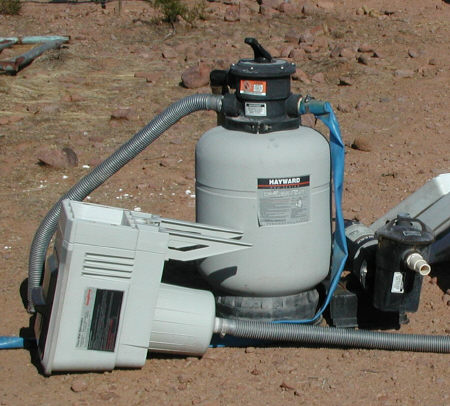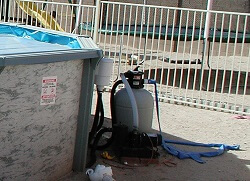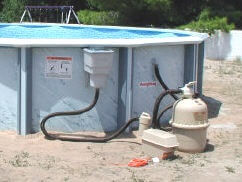Above Ground Pool Filter Installation
When The Filter Directions Can't Be Found
The tips on this page should help you with your above ground pool filter installation, without any leaks. It is also important to have the water flowing the proper direction, so we will cover that first.
To get the water flowing the right direction remember this tip - basket to basket. This means that your skimmer should flow directly into the hair and lint pot on the front of the pump. The skimmer basket to the lint pot basket, that's the direction the water needs to flow.
With that done, the clean water coming out of the filter goes back into the pool through the pool return fitting.
Filter Installation - Fittings

Some systems may have couplers with o-rings instead of threaded adapters. If so, just follow the instructions, as they are very easy to install. The threaded adapters need to be taped and doped before installing. I use a product call T+2 made by Teflon on the threads first, I then use Teflon tape over that. Using the combination of the two sealers is a sure way to never have an above ground pool filter system leak.
In a standard Hayward package you may have four different kinds of adapters. Check the instructions for proper placement. The standard hose adapters go on the front of the pump and on the port opening labeled return. A high pressure barbed fitting goes on top of the pump and a similar one with an elbow goes in the opening labeled pump on the valve assembly. The waist port may have a special fitting or it might use a standard adapter. Some systems do not come with a waist fitting, in which case you just need a 1 1/2" PVC male adapter and about 6" of 1 1/2" PVC pipe. This is the fitting the collapsible backwash hose will attach to.

You need to determine the direction and angle that the elbow adapter needs to be at when it is tight. These adapters will usually snug up close to the right spot, but not always. I tighten this fitting as tight as it will go and then back it up just enough to point in the right direction. The other two adapters can then be installed.
Filter Installation - Media
With a sand filter you will need to add media to the tank before installing the completed valve assembly. Water should be added to the tank, just enough to cover the laterals in the bottom. With either tape or the plastic cover provided, cover the pipe coming up the center of the tank. Add the correct amount of media and carefully clean the top of the tank before installing the valve assembly.
Be sure to grease the o-ring before installing the valve. If a little tube of grease came with your system go ahead and use that. If you did not get any, and most systems don't provide it, buy a tube of aqua-lube at your pool store. You will be using this to grease the o-ring on your hair and lint pot on a regular basis.
Filter Installation - Hoses

You should now be ready to finish filling the pool and start the filter. A sand filter should be started in the back flush position. This allows the dust in the media, or silica sand, to go out the waist and not into the pool.
After the back flush, switch to filter mode and check for any leaks. Hopefully you won't have any. If a hose clamp leaks try tightening it some more. If that does not work loosen it, twist the hose a little, and tighten it back up in a slightly different position. Sometimes the leaks can be real stubborn and the addition of a second clamp is needed. One way or the next, all hose leaks can be fixed. Don't let you filter drip water, take the time to make it completely leak free.
The pages below lead to a lot of questions and answers, useful reading for all new above ground pool owners.
Above Ground Pool Questions and Answers
Above Ground Pool Help
Above Ground Pool Questions
Above Ground Pool Q and A
Above Ground Pool Tips
Above Ground Pool FAQ's
Above Ground Pool Questions with Answers
Above Ground Pool FAQ
Above Ground Swimming Pools
Ask the Pool Pro any question you may have about above ground pools.